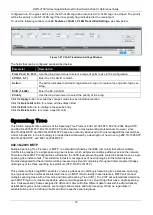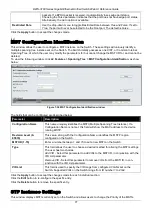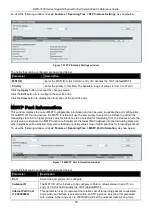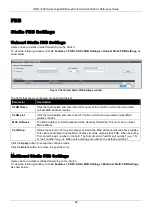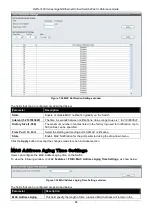
DWS-3160 Series Gigabit Ethernet Unified Switch Web UI Reference Guide
72
configured rule. On egress at this port, the SP-VLAN tag will be recovered to C-VLAN tag or be striped. The priority
will be the priority in the SP-VLAN tag if the inner priority flag is disabled for the receipt port.
To view the following window, click
L2 Features > QinQ > VLAN Translation Settings
, as show below:
Figure 7-27 VLAN Translation Settings Window
The fields that can be configured are described below:
Parameter
Description
From Port / To Port
Use the drop-down menus to select a range of ports to use in the configuration.
CVID (1, 5-7)
Enter the C-VLAN ID to match.
Action
The action indicates to add an S-tag before a C-tag or to replace the original C-tag by an
S-tag.
SVID (1-4094)
Enter the SP-VLAN ID.
Priority
Use the drop-down menu to select the priority of the s-tag.
Click the
Apply
button to accept the changes made for each individual section.
Click the
Delete All
button to remove all the entries listed.
Click the
Edit
button to re-configure the specific entry.
Click the
Delete
button to remove a specific entry.
Spanning Tree
This Switch supports three versions of the Spanning Tree Protocol: 802.1D-1998 STP, 802.1D-2004 Rapid STP,
and 802.1Q-2005 MSTP. 802.1D-1998 STP will be familiar to most networking professionals. However, since
802.1D-2004 RSTP and 802.1Q-2005 MSTP have been recently introduced to D-Link managed Ethernet switches,
a brief introduction to the technology is provided below followed by a description of how to set up 802.1D-1998 STP,
802.1D-2004 RSTP, and 802.1Q-2005 MSTP.
802.1Q-2005 MSTP
Multiple Spanning Tree Protocol, or MSTP, is a standard defined by the IEEE community that allows multiple
VLANs to be mapped to a single spanning tree instance, which will provide multiple pathways across the network.
Therefore, these MSTP configurations will balance the traffic load, preventing wide scale disruptions when a single
spanning tree instance fails. This will allow for faster convergences of new topologies for the failed instance.
Frames designated for these VLANs will be processed quickly and completely throughout interconnected bridges
utilizing any of the three spanning tree protocols (STP, RSTP or MSTP).
This protocol will also tag BPDU packets so receiving devices can distinguish spanning tree instances, spanning
tree regions and the VLANs associated with them. An MSTI ID will classify these instances. MSTP will connect
multiple spanning trees with a Common and Internal Spanning Tree (CIST). The CIST will automatically determine
each MSTP region, its maximum possible extent and will appear as one virtual bridge that runs a single spanning
tree. Consequentially, frames assigned to different VLANs will follow different data routes within administratively
established regions on the network, continuing to allow simple and full processing of frames, regardless of
administrative errors in defining VLANs and their respective spanning trees.















